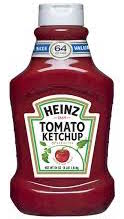When our daughter, Kelly, was little, she wouldn’t eat anything if it didn’t have ketchup on it. For years, a friend of ours always gave Kelly something for Christmas or her birthday that was in some way related to ketchup.
I guess when I think of ketchup, I think of Heinz, and Pittsburg and the Steelers and the “red zone.”
Pittsburg is the headquarters of H.J. Heinz Company that was founded about 125 years ago. I’ve heard it said that Pennsylvania is where ketchup was invented (and by Herr Heinz.)
But — my extensive research says that’s not so — It’s not even close…. well, actually Pennsylvania does get the credit for tomato ketchup, but now I’m spoiling the story….
I hope you’re ready for this — the ancestor of modern ketchup was completely tomato-free. Actually, the precursor to what we call ketchup was a fermented fish sauce from (where else?) China!. As far back as 300 B.C., texts began documenting the use of fermented pastes made from fish intestines, meat byproducts and soybeans. The fish sauce — called “ge-thcup” of “koe-cheup” by speakers of the Southern Chinese Min dialect, was easy to store on long ocean voyages.
The pastes or sauces spread along the trade routes to Indonesia and the Philippines, where British traders, in particular, developed a taste for the salty condiment. They took samples home and promptly corrupted the original recipe.
During the 18th century, cookbooks featured recipes for ketchups made of oysters, mussels, mushrooms, walnuts, lemons, celery and even fruits like plums and peaches. Usually, the ingredients were either boiled down into a syrup—like consistency or left to sit with salt for extended periods of time. Both these processes led to a highly concentrated end product — with a salty, spicy flavor that could last for a long time without going bad.
Finally, in 1812, the first recipe for tomato-based ketchup was invented. James Mease, a Philadelphia scientist, is credited with developing the recipe. He wrote that the choicest ketchup came from “love apples.” That was what tomatoes used to be called — some believed they had aphrodisiac powers.

Before vinegar became a standard ingredient, preservation of tomato-based sauces was an issue, as the fruits would quickly decompose. A relatively new company called Heinz introduced its famous formulation in 1876, which contained tomatoes, distilled vinegar, brown sugar, salt and various spices. They also pioneered the use of glass bottles, so customers could see what they were buying.
Tomato-based ketchup slowly became the ubiquitous form of the condiment in the U.S. and Europe. Today Heinz is the best selling brand of ketchup in the United States.
Jeff Foxworthy said you might be a redneck if your only condiment on the dining room table is the economy size bottle of ketchup — but if it is, you can be sure it’s bright red and made with tomatoes.
— 30 —
